- The purpose of the lesson is to get to know
- with major literary currents late XIX –
- early twentieth century
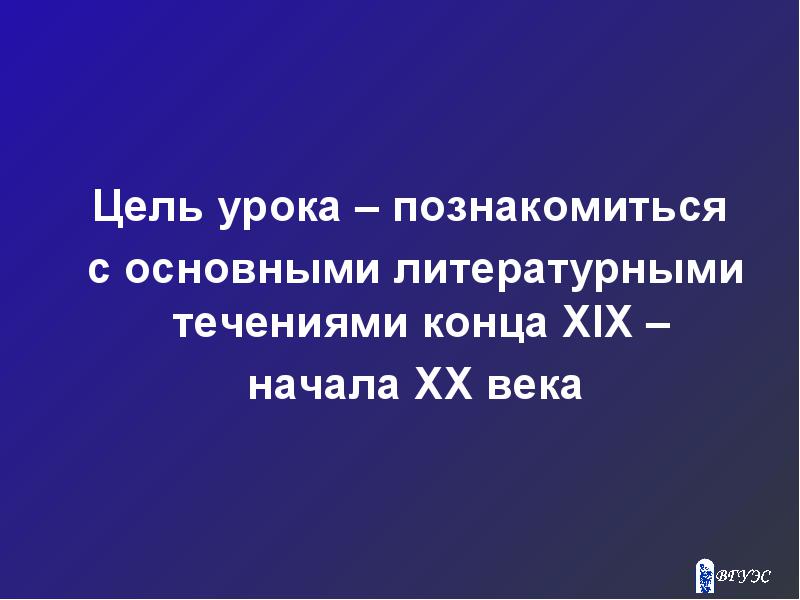
Tasks:
1. Analyze the main literary movements of the late 19th - early 20th centuries.
2. Get to know the representatives of symbolism, acmeism, futurism.
3. Get acquainted with the work of Sergei Yesenin - representative of imagism.
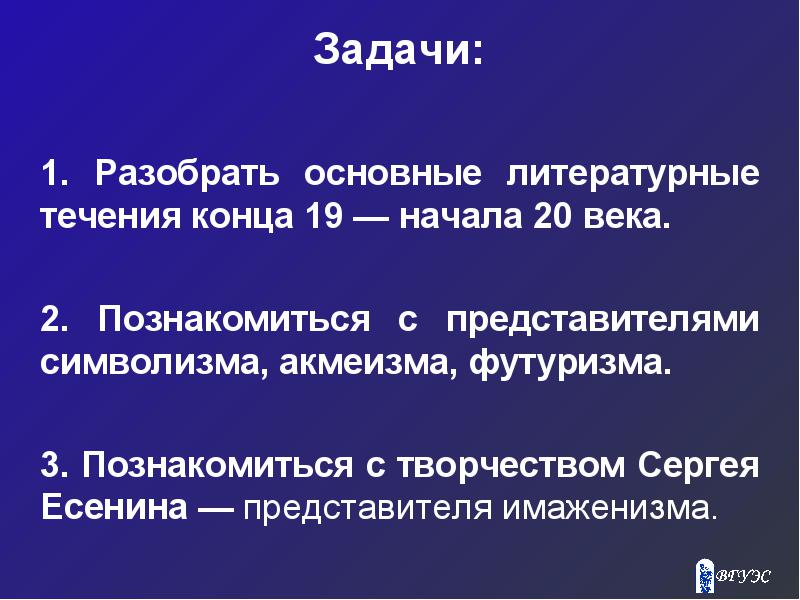
Questions to repeat the studied material
What Russian writers of the 19th - early 20th centuries can you name?
What are the main motives of their work do you know?
What literary movements are you familiar with?

LITERARY TRENDS OF THE END OF THE 19TH - BEGINNING OF THE 20TH CENTURY
The end of the 19th - the beginning of the 20th century is the era of the Russian cultural revival.
In the era of the cultural renaissance, there was an explosion in all areas of culture:
not only in poetry, but also in music;
not only in the visual arts, but also in the theater.
Russia of that time gave the world a large number of new names, ideas, masterpieces.

SYMBOLISM
A trend in European and Russian art that arose at the turn of the 20th century, focused mainly on artistic expression with the help of a SYMBOL of ideas that are beyond sensory perception.
Representatives of symbolism
In the early 1900s, within symbolism,
3 currents:
1. Nikolai Minsky, Dmitry Merezhkovsky- in the beginning, civil poetry, then - the ideas of religiosity.
2. Valery Bryusov, Konstantin Balmont("senior symbolists") - considered symbolism as a new stage of development after realism - historical and cultural problems, rationalism, completeness of images, declamatory system.
3. "Junior Symbolists" - Alexander Blok, Andrey Bely, Vyacheslav Ivanov- philosophical and religious understanding of the world - mystical motives, grotesque perception of reality.

ACMEISM
Separated from symbolism in the early 1910s.
Acmeism is a living process in which everything is in a state of change. It does not have a rigid framework, as in symbolism, but there is only a direction in the thinking of poets. The main thing for the acmeists was the thesis of the rehabilitation of earthly existence.
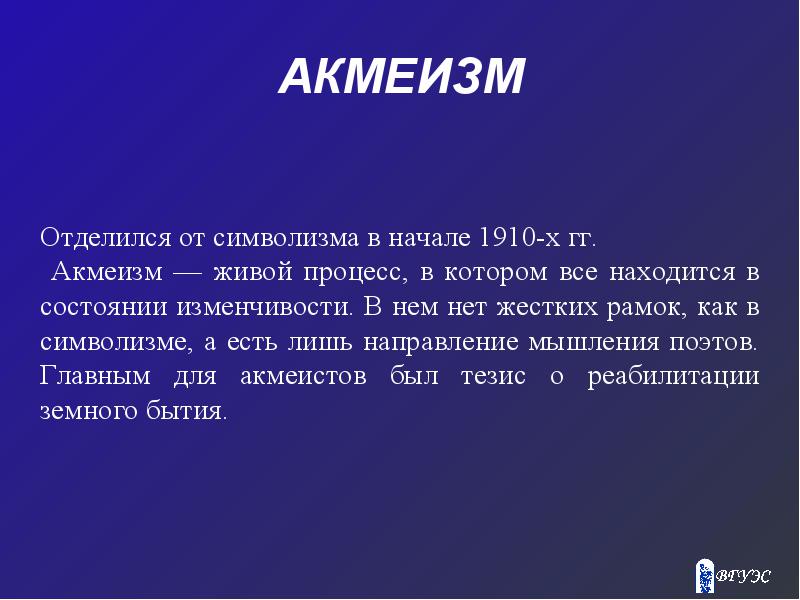
Representatives of acmeism
Acmeists have taken it upon themselves to restore the world to its intrinsic value. All objects and phenomena are good in themselves.
The main thing for the acmeists was the thesis of the rehabilitation of earthly existence.
-Nikolai Gumilyov
-Osip Mandelstam
-Anna Akhmatova

FUTURISM
One of the universal art movements of the early 20th century.
The Futurists were distinguished by an impulse to freely create new forms capable of expressing the essence of the future art and life arrangement;
Futurism gave rise to many innovative ideas and significant movements in literature, painting, theater, and music.

Representatives of futurism
Futurists wrote on the themes of the city, machine civilization, general chaos, and the breaking of habitual ties.
They used complex types of rhymes.
Velimir Khlebnikov, David Burliuk, Vasily Kamensky, Pavel Filonov, Alexei Kruchenykh,
1. cubo-futurism - Vladimir Mayakovsky,
2. egofuturism - Igor Severyanin,
3. imaginism - Boris Pasternak, Sergei Yesenin.
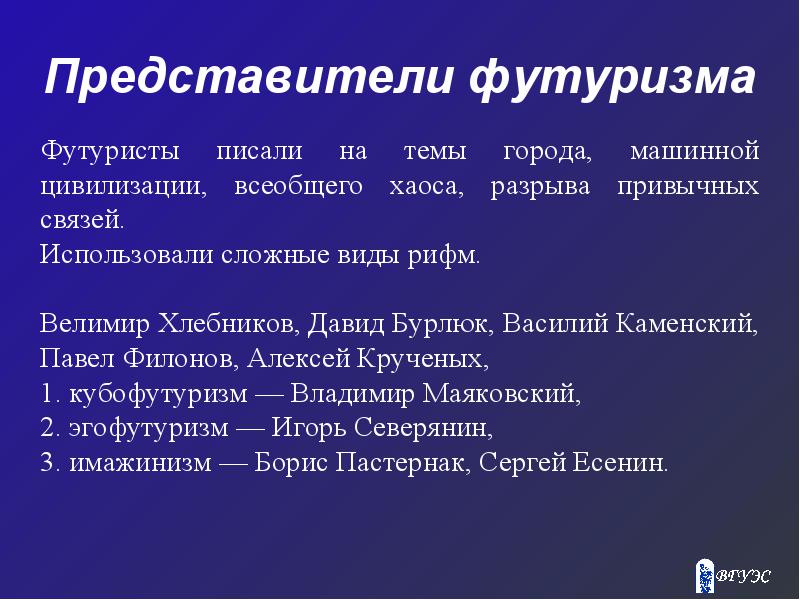
Sergei Alexandrovich Yesenin (1895-1925)
One of the most popular and famous poets of the 18th and 19th centuries.

Biography of S.A. Yesenin
- Born on September 21 (October 3), 1895 in the village of Konstantinovo, Ryazan province
- In 1904 - studying at the Konstantinovsky Zemstvo School, then - studying at a church teacher's school
- In 1912 - moving to Moscow
- In 1913 - admission to the Moscow State National University. A.L. Shanyavsky
In 1914 - the first publication of poems
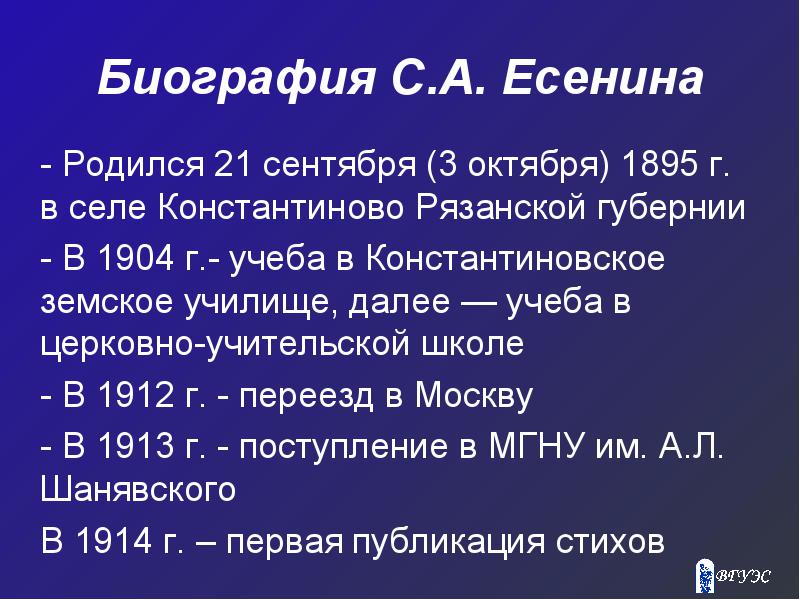
Biography of S.A. Yesenin
- In 1915 - arrival in St. Petersburg, reading poetry by A.A. Block, S.M. Gorodetsky
- Performance in "folk" clothes in front of the public
- In 1918-1920. - active participation in the Moscow group of Imagists
- In 1921 - a visit to Central Asia, the Urals and the Orenburg region

Biography of S.A. Yesenin
1921 - married to A. Duncan
From 1922 to 1923 - life in Europe and the USA
In 1924-1925. - Azerbaijan
December 28, 1925 - death
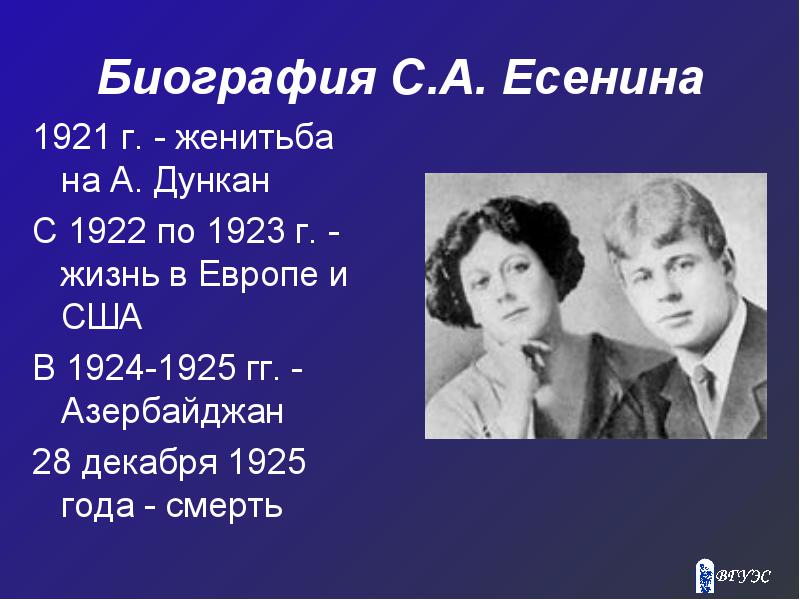
Creativity S.A. Yesenin
Lyric themes:
Love
Nature
motherland
The revolution
Motives:
"Peasant Russia"
Christian motives

Creativity S.A. Yesenin
The difficult life of the beginning poet, his spiritual maturation was reflected in the lyrics of 1910-1913. (about 60 poems and poems): love for all living things, for life, for the Motherland. The surrounding nature especially tunes the poet in this way:
“The scarlet light of dawn wove out on the lake ...”, “Smoke high water ...”,
"Birch", "Spring Evening", "Night",
“Sunrise”, “Winter sings - calls out ...”,
"Stars", "Dark night, can't sleep...", etc.

Creativity S.A. Yesenin
From the very first verses, Yesenin's poetry includes the themes of the motherland and revolution.
From January 1914, Yesenin's poems appear in print ("Birch", "Blacksmith", etc.).
The poetic world becomes more complex, multidimensional, and biblical images and Christian motifs begin to occupy a significant place in it.
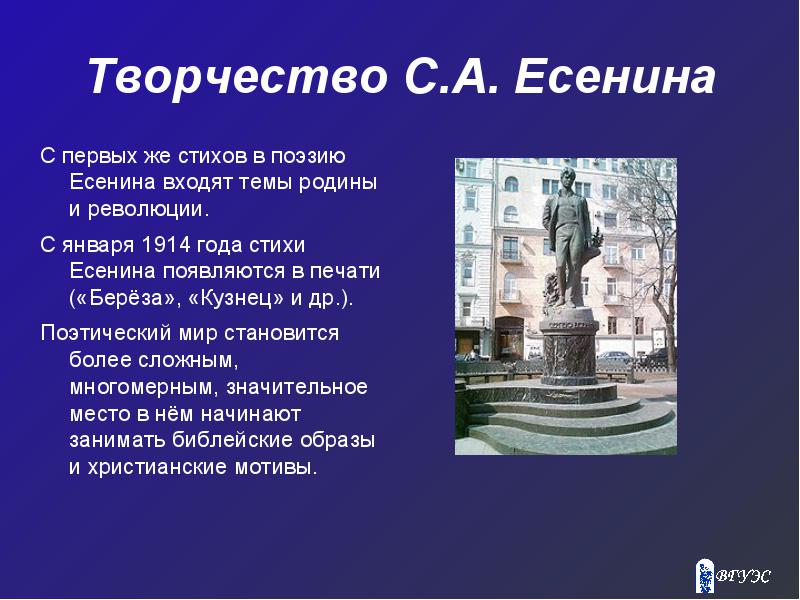
Creativity S.A. Yesenin
- At the beginning of 1916, Radunitsa (1910-1915) was published.
- Creativity of 1914-1917: "Mikola", "Egoriy", "Rus", "Marfa Posadnitsa", "Us", "Child Jesus", "Dove", etc.
- The basis of the universe is a hut. The huts form a village. And the village, bounded by the outskirts, is Yesenin Rus, which is cut off from big world forests and swamps.
- No end in sight, only blue sucks eyes ...

Creativity S.A. Yesenin
Collection "Rural Book of Hours" (1918) Yesenin is a subtle lyricist, master of landscape, singer of peasant Russia, connoisseur of the folk language and folk soul.
Tragic attitude, spiritual confusion are expressed in the cycles "Mare's Ships" (1920), "Moscow Tavern" (1924), the poem "The Black Man" (1925).
In the poem "The Ballad of Twenty-Six" (1924), dedicated to the Baku commissars, the collection "Soviet Russia" (1925), the poem "Anna Snegina" (1925), Yesenin sought to comprehend the "commune rearing Russia", although he continued to feel like a poet "Russia leaving ”, “golden log hut”.

Creativity S.A. Yesenin
Dramatic poem "Pugachev" (1921).
Many songs were written to Yesenin’s poems: “A Letter to the Mother” and “You Are My Fallen Maple”, “Moon Above the Window”, “Gulyak”, “You don’t love me, don’t feel sorry for me”, “Stars”, “Moscow”, etc.
Many of these songs are perceived as folk songs.

Thank you for your attention!

Using Presentation Materials
The use of this presentation may be carried out only subject to the requirements of the laws of the Russian Federation on copyright and intellectual property, as well as taking into account the requirements of this Statement.
The presentation is the property of the authors. You may print a copy of any part of the presentation for your personal, non-commercial use, but you may not print any part of the presentation for any other purpose or modify any part of the presentation for any reason. The use of any part of the presentation in another work, whether in print, electronic or otherwise, as well as the use of any part of the presentation in another presentation by reference or otherwise, is permitted only after obtaining the written consent of the authors.
Economic and political shaking at the end of the 19th and beginning of the 20th century (the birth of the bourgeoisie, the abolition of serfdom) contributed to the emergence of new literary movements. Realism is replaced by proletarian literature, modernism (modern) appears.
Modernism includes: symbolism, acmeism and futurism.
Symbolism
Symbolism is the first major movement that arose in Russia. It was started by Dmitry Merezhkovsky and Valery Bryusov. Representatives of this movement central importance in their work they gave to the symbol.
In 1812, the first collection of poems by Russian symbolists was published.
Then came the second collection and the third. It was assumed that these collections contained various poets. But it soon became clear that the author of all the poems in these collections was the novice poet Valery Bryusov, who signed the poems with various pseudonyms. His ploy succeeded and the Symbolists were noticed. And soon new symbolist authors began to appear.
Symbolists are divided into:
young symbolists - Vyacheslav Ivanov, Andrey Bely, Alexander Blok.
senior symbolists - Valery Bryusov, Solovyov, Balmont, Zinaida Gippius, Fedor Sologub.
They preached art for art's sake. But disputes arose between them. The elders defended the priority of religious and philosophical searches, and the young Symbolists were considered decoders.
Decodenism (translated from French - decline) - in literature, this is a crisis type of consciousness, which is expressed in a feeling of despair, impotence. Therefore, representatives of this trend have a lot of despondency and sadness.
Acmeism - originated in 1910 and is genetically associated with symbolism. Representatives of this trend are: Vyacheslav Ivanov, Sergei Gorodetsky, Nikolai Gumelev, Alexei Tolstoy. Soon they united in the circle "Workshop of poets", which was joined by Anna Akhmatova, Zinkeyvich, Mindelshpam. Acmeists, unlike the Symbolists, advocated showing the values of life, abandoning the unchaste desire of the Symbolists to know the unknowable. According to acmeists, the purpose of poetry is the artistic development of the diverse world around us.
Futurism
Futurism (future) is an international literary phenomenon. The most extreme in terms of aesthetic radicalism that arose in Italy and almost immediately arose in Russia after the publication of the futuristic society "Judges' Garden". Futurist authors were: Dmitry Burlyuk, Khlebnikov, Kamensky, Mayakovsky. Futurists were divided into three groups:
ego-futurists - Igor Ignatiev, Olympov, Gnedov, and others.
Cuba-futurists - Ivnev, Krisanf.
centrifuge - Boris Pasternak, Bobrov, Ageev, Bolshakov, etc.
Representatives of futurism called for cutting off everything old and creating new literature capable of transforming the world.
Futurists said:
"From the height of skyscrapers we look at their insignificance"
So they talked about Gorky, Gumilyov and Blok.
The 19th century is called the "Golden Age" of Russian poetry and the century of Russian literature on a global scale. At the beginning of the century, art was finally separated from court poetry and "album" poems, the features of a professional poet appeared for the first time in the history of Russian literature, the lyrics became more natural, simpler, more humane. This century gave us such masters. It should not be forgotten that the literary leap that took place in the 19th century was prepared by the entire course of the literary process of the 17th and 18th centuries. The 19th century is the time of the formation of the Russian literary language.
The 19th century began with the heyday of sentimentalism and the formation of romanticism. These literary trends found expression primarily in poetry.
Sentimentalism: Dominant " human nature"sentimentalism declared a feeling, not a mind, which distinguished it from. Sentimentalism believed that the ideal of human activity was not the "reasonable" reorganization of the world, but the release and improvement of "natural" feelings. His character is more individualized, his inner world enriched with the ability to empathize, sensitively respond to what is happening around. By origin and conviction, the sentimentalist hero is a democrat; rich spiritual world commoner - one of the main discoveries and conquests of sentimentalism.
Romanticism: ideological and artistic direction in the culture of the end - the first half. It is characterized by the assertion of the inherent value of the spiritual and creative life of the individual, the image of strong (often rebellious) passions and characters, spiritualized and healing nature. In the 18th century, everything that was strange, fantastic, picturesque, and existing in books, and not in reality, was called romantic. At the beginning of the 19th century, romanticism became the designation of a new direction, the opposite of and. Romanticism affirms the cult of feelings and the natural in man. The image of the “noble savage”, armed “ folk wisdom and not spoiled by civilization.
In Russian romanticism, freedom from classical conventions appears, a ballad, a romantic drama, is created. A new idea of the essence and meaning of poetry is affirmed, which is recognized as an independent sphere of life, an expression of the highest, ideal aspirations of man; the old view, according to which poetry was an empty pastime, something completely serviceable, is no longer possible.
The founder of Russian romanticism is Zhukovsky: Russian poet, translator, critic. At first he wrote sentimentalism because of his close acquaintance with Karamzin, but in 1808, along with the ballad “Lyudmila” that came out from under his pen (. alteration of “Lenora”), Russian literature included a new, completely special content -. Participated in the militia. V became a reader under the Dowager Empress. In he became a teacher of the Russian language to Princess Charlotte - the future Empress, and in the fall he was appointed to the position of "mentor" to the heir to the throne, the future emperor.
Poetry can be considered the pinnacle of Russian romanticism. In the eyes of the progressive part Russian society 30s 19th century features appeared romantic vision, caused by dissatisfaction with modern reality. This worldview was distinguished by deep disappointment, rejection of reality, disbelief in the possibility of progress. On the other hand, the romantics were characterized by the desire for lofty ideals, the desire to completely resolve the contradictions of being and the understanding of the impossibility of this (the gap between the ideal and reality).
Lermontov's work most fully reflects the romantic worldview that was formed in Nicholas era. In his poetry, the main conflict of romanticism - the contradiction between the ideal and reality - reaches extreme tension, which significantly distinguishes him from the romantic poets of the early 19th century. The main object of Lermontov's lyrics is the inner world of a person - deep and contradictory. our time". Key theme in creativity Lermontov - theme tragic loneliness of the individual in a hostile and unjust world. All wealth is subject to the disclosure of this topic. poetic images, motives, artistic means, all the variety of thoughts, experiences, feelings of the lyrical hero.
Important in the works of Lermontov is such a motive as, on the one hand, the feeling of "immense forces" human soul, and on the other - uselessness, vain vigorous activity, dedication.
In various of his works, the themes of the motherland, love, the poet and poetry are viewed, reflecting the features of the bright personality and worldview of the poet.
Tyutchev: Philosophical lyrics are both the completion and the overcoming of romanticism in Russia. Starting with odic works, he gradually found his own own style. It was something like a fusion of Russian odic poetry and the tradition of European romanticism. In addition, he never wanted to see himself as a professional writer and even neglected the results of his own creativity.
Along with poetry began to develop prose. Prose writers of the beginning of the century were influenced by English historical novels W. Scott, whose translations were very popular. The development of Russian prose of the 19th century began with the prose works of A.S. Pushkin and N.V. Gogol.
Early poetry also developed within the framework of Romanticism. His southern exile coincided with a number of historical events, and in Pushkin the hope was ripening for the attainability of the ideals of freedom and liberty (the heroism of modern history of the 1820s was reflected in Pushkin's lyrics), but after several years of cold receptions of his works, he soon realized that the world was ruled not opinions, but power. In the work of Pushkin of the romantic period, the conviction matured that objective laws operate in the world, which a person cannot shake, no matter how brave and beautiful his thoughts are. This determined the tragic tone of Pushkin's muse.
Gradually, in the 30s, the first "signs" of realism appeared in Pushkin.
From the middle of the 19th century, the formation of Russian realistic literature, which is created against the backdrop of a tense socio-political situation that developed in Russia during the reign of Nicholas I. A crisis in the feudal system is brewing, contradictions between the authorities and the common people are strong. There is a need to create a realistic literature that sharply reacts to the socio-political situation in the country. Writers turn to the socio-political problems of Russian reality. Socio-political and philosophical problems prevail. Literature is distinguished by a special psychologism.
Realism in art, 1) the truth of life, embodied by the specific means of art. 2) A historically specific form of the artistic consciousness of the new time, the beginning of which is either from the Renaissance ("Renaissance realism"), or from the Enlightenment ("Enlightenment realism"), or from the 30s. 19th century ("proper realism"). The leading principles of realism in the 19th - 20th centuries: displaying the essential aspects of life in combination with the height of the author's ideal; reproduction of typical characters, conflicts, situations with the completeness of their artistic individualization(i.e. concretization of both national, historical, social signs, as well as physical, intellectual and spiritual features); preference in the ways of depicting the "forms of life itself", but along with the use, especially in the 20th century, conditional forms(myth, symbol, parable, grotesque); prevailing to the problem of "personality and society"
Gogol was not a thinker, but he was a great artist. About the properties of his talent, he himself said: "I only came out well, what was taken by me from reality, from the data known to me." It could not have been easier and stronger to indicate that deep foundation which lay in his talent.
critical realism - artistic method and literary direction, formed in . Its main feature is the image human nature in organic connection with social circumstances, along with deep social analysis the inner world of man.
Literature inherited its publicism and satirical character from the 18th century. In a prose poem N.V. Gogol"Dead Souls" writer in a sharp satirical manner shows a scammer who buys dead Souls, Various types landlords who are the embodiment of various human vices. In the same plan, the comedy "The Inspector General" is sustained. are full satirical images and works by A.S. Pushkin. Literature continues to satirically depict Russian reality. The tendency to depict the vices and shortcomings of Russian society - characteristic throughout Russian classical literature. It can be traced in the works of almost all writers of the 19th century. At the same time, many writers implement the satirical trend in a grotesque (bizarre, comic, tragicomic) form.
The genre of the realistic novel is developing. Their works are created by I.S. Turgenev, F.M. Dostoevsky, L.N. Tolstoy, I.A. Goncharov. The development of poetry is somewhat calming down.
Its useful to note poetic works Nekrasov, who was the first to introduce social issues into poetry. His poem “Who is living well in Russia?” is known, as well as many poems, where the difficult and hopeless life of the people is comprehended.
